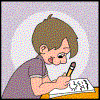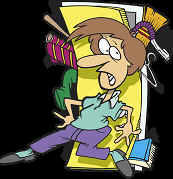| |
 |
Writing
Well
By Leon
of Leon's Planet
©2000 ~ present
|
 |
How to write for
anything!
I especially
welcome
Homeschoolers!
Introduction
| Hi.
My name is Leon. I am the webmaster and sole contributor to
content on this website. I have taught English for 25 years
(mostly elementary) and
those students who listen to me, and follow my instructions score very
well on their writing assignments and writing tests. No matter
what you are writing for, I have a template which you can follow to get
a good writing score. To see ALL of my credentials, please click here. |
Table of Contents
The Writing Process
As an elementary teacher (and teacher of writing) for 25
years, I am a firm believer in the 'writing process'. It works!
You've heard the saying, "Practice makes
perfect." Well, that's not always true. The truth is perfect
practice makes perfect. And, that's the basic philosophy behind the
'writing process'. Also, it should be noted that professional writers
follow the writing process. Why would a student be any better than a
professional writer?
What is the writing process?
This is an overview of the writing process. I'll give details
below it.
| Step 1: Pre-write (Get ideas) |
| Step 2: Write (1st draft) |
| Step 3: Re-write (Revise) |
| Step 4: Editing (Spelling and Grammar) |
| Step 5: Re-write (Final Draft) |
| Step 6: Publish (deliver to an audience) |
You can see that the writing process is kind of
lengthy. I would do one step per day.
Now, for the details...
| Step 1: Pre-write
The 'pre-write' stages is where writers get their ideas for
writing. As a teacher, I did this by reading either a storybook,
or a piece of writing that I had written myself (in the genre of the
assignment). This gets the junior-writers'
mental juices flowing and they want to write their own compositions.
(Yes! They actually get excited about writing their own
compositions). Then, we talk about the template (I have templates)
for proper writing
(for whichever genre we are writing). I actually show the students
how I followed the template in my writing (or in the story that I read
to them).
Also, part of the pre-writing stage is making a "map" (for
fiction), or an outline (for non-fiction) for one's writing. For writing stories (narratives), feel
free to use my story map (or any story map that you can find
online that has all five story elements). For non-fiction writing
(like reports), you'll have to teach your students how to make an
outline. |
| Step 2: Write (1st Draft)
The junior-writer writes freely, without worrying about spelling or
grammar. The idea is that one just gets one's ideas on paper in as
logical a manner (following the map or outline as a guide).
Caution: Just from personal experience, I would
discourage dialogue in the stories. I've gotten alleged
"stories" from students that was 90% dialogue, with no real
plot. I'm not saying completely forbid dialogue in stories, but
limit it as much as possible. Students do have to learn how to
read and write speech (using speech marks) and reported speech (which is
without the speech marks); but just limit it for the sake of producing
good-quality storylines. |
| Step 3: Revise
This step has to be done with the guidance and supervision of a
tutor/teacher. The tutor/teacher sits down with the child and
discusses the following (perhaps use this as a kind of checklist):
(1) Did I (the writer) follow the "map" or outline in
my writings? [If not, that needs to be rectified].
(2) Did I (the writer) provide sufficient information to the
reader {Because sometimes junior-writers just assume that the reader knows
stuff that they should not assume}. [If not, that needs to be
rectified]. NOTE: Writers should assume that the reader knows nothing!
(3) How could I (the writer) add more information to make the
composition more interesting to the reader?
Then, the junior-writer re-writes the composition (or adds in the margins
if the writer is giving you a hard time). |
| Step 4: Editing
This step is supposed to be done in peer-groups, but I think that is
inane, because the peers are not experts in editing. So, as the
teacher, I do this step entirely by myself. (You can do it with
the junior-writer present). As the Editor, I correct all spelling and
grammar issues (because everything else should be fixed by now). |
| Step 5: Final Draft
This is the easiest step. The jr-writer just re-writes the
composition fixing all the spelling and grammatical errors. Then,
they get to add illustrations to go with their compositions. |

Step 6: Publishing
This the funnest step. The junior-writer gets to present his/her
work to either other readers and/or an audience. As a teacher, we
did both. I compiled all their "perfect" compositions
into a book, copied and gave each student a copy. Then, we held
"author's chair," which is when the junior-writer gets to read
his/her composition to the whole class. My students absolutely
loved publishing their work. I did it every year with my students
with great success. (Parents loved it, too!) |
| NOTES to Parents/Teachers:
I always tell my students beforehand all about the writing process,
and I explain to the children that this process will take a long time,
but in the end we will get to present our stories to an audience (or to
various audiences). This motivates the children to endure the
arduous writing process. But, in the end, they have created an
original, perfect piece of literature that they can be proud of and
share with whomever they want to share it. |
Writing Templates
(These were created by me, Leon, after 25 years of
teaching writing).
Narrative
Writing
(Story Writing) |
Writing
a Persuasive Paper or Essay |
Non-fiction
Writing
Writing a Report |
I. 1st
paragraph: SETTING
a. Setting (Time and
Place)
1. TIME: Time doesn't mean clock time (although that
might be important, depending on the plot). NO. Rather
it means, tell the reader the year and the season. You don't
have to give the exact date, unless you really want to.
2. Describe in detail the place.
3. Mention the main character.
II. 2nd paragraph: CHARACTER
a. Character
development
1. Describe your main character in great detail.
2. You may want to describe other characters as well.
III. PROBLEM
a. Every narrative must
have a problem and a solution. You will make new paragraphs
only if/when the time or place changes.
IV. SOLUTION or Resolution
a. If there is no
solution to the problem, there must be a resolution. A
resolution is what happened as a result of the problem not being
solved. You will make new paragraphs only if/when the time
or place changes.
V. ENDING
a. A common fairytale
ending is, "And they lived happily ever after."
However, your ending should be more creative and imaginative.
VI. SHARE
a. I think it is very
important to share one's work and get feedback (both positive and
critique-like feedback). We can all improve our writing
skills.
SUGGESTION:
Make a Title Page
with Title
and "by ______________";
and illustrate. |
I. 1st
paragraph: Introduction
a. Your first
sentence should be an attention-getter! It should get your
reader's attention.
b. Introduce your topic
to the reader.
c. Give your
opinion (briefly)
d. Some writers may
wish to hide their opinion until the end, but I suggest you don't.
II. 2nd paragraph: Pro (support)
a. You must support
your opinion with 2 or 3 examples (3 is better).
III. 3rd paragraph: Con (against)
a. Give some of the
examples which are against your opinion.
IV. 4th paragraph: Counter Strike
a. Counter the
"cons". Give your reason why the cons are not
correct or strong enough.
V. 5th paragraph: Conclusion
a. Give your
opinion (or restate your opinion.
b. Summarize your
"pros" (support) very briefly. (I can do this in
one sentence).
VI. Sources
a. For this style of
writing, MLA
format is used to document one's sources of
information.
b. For younger
learners, just have them make a list of their
resources/sources at the end of the document. It would be
good for them to get into the habit of documenting sources,
because plagiarism is taken very seriously in upper grades.
c. As to how many
different sources are required, that is entirely up to the teacher
or professor. When I'm writing for myself, it takes as many
as it takes to get the point across. The general rule
is: the more sources the better.
|
I. 1st
paragraph: Introduction
a. Maybe start with an
attention-getter. (I really like to do this, but it is not a
requirement).
b. TELL THEM WHAT
YOU'RE GOING TO TELL THEM. (Give a brief introduction to
what you will cover in your report).
II. Body
a. TELL THEM.
This will take several paragraphs or possibly even several pages
(depending upon which grade you are in). Each paragraph will
deal with a certain aspect of the topic you have chosen.
(For upper grades, make sure you are following APA
format, to document your sources along the way.)
III. Summary
a. TELL THEM WHAT YOU
JUST TOLD THEM. Give a brief summary of all that you just
wrote in the body. I can usually do this in two or three
sentences. IV. Sources
a. With Non-fiction writing,
the writer is usually asked to provide sources of information used
in the author's writing, so as to not be accused of plagiarism.
b. RE:
"Bibliography"
The word "bibliography" has fallen out of use, because
the word "biblio" means book in Greek and nowadays, most
sources of information don't even come from books.
c. RE: Resources
The words "resources" and "sources" are used
pretty-much interchangeably. Personally, I'm partial to
using "Sources", but ask your teacher/professor which
one he/she prefers.
d. For this style of
writing, use APA
format for documenting sources
e. For younger
learners, just have them make a list of their sources at the
end of the document under the heading "Sources".
It's good to get into the habit of citing sources at a young age. |
Important: Paragraphs must be "connected" with
connecting phrases as well, as best as one can.
Story Hand
This is called "The Story Hand". Feel free to copy.
Make a poster of it.
I would have it posted in every classroom around the world to remind students of
the 5 elements of a story.
If it doesn't have all five elements, it's not a complete story.

Story Map

|
How to Use the Story Map
RE: Name and Date
I like all of my students to get into the habit of writing their name and
date on everything (unless you are using a workbook; in that case
the name should be on the book). This will be a VERY useful habit in
your child's / pupil's future.
RE: Title
I really encourage my students to do the title last (even though its at
the top). Because you want a captivating title that both matches the
story and will catch the attention of potential readers.
RE: Setting
Every first paragraph should start with the setting and a brief
introduction of the main character(s). The writer should develop
those characters in the second paragraph. I used to put "Time
and Place" for the setting and I got things like 5 o'clock at my
house. So, I learned to be more specific as to what is wanted in a
setting.
RE: Character Development
Students are (unfortunately) not born with the innate knowledge on how to
develop their characters, so I had to be specific. If they want to
add more, great! Certainly, older students should add more.
RE: Plot
BE WARNED... beginners at using story maps will try to fit the entire plot
into those two little boxes. Tell them that they get one or two
sentences (max) for each box, to briefly describe the problem and
solution. In the first draft, it will take multiple
paragraphs. A new paragraph is started whenever the time or place
changes (but they don't need to worry about paragraphs when writing the
first draft).
RE: Ending
BE WARNED... beginners will like to end their story with "The
End". That's fine, but it's not what is wanted for the
ending. The ending is what happens after the solution. Say,
the main characters defeat the monster. Well, great! Then,
what? Did they have a party to celebrate? Did they go home and
go straight to bed because they were so tired? What? |
Writing for Tests
Common English
Writing Exams
|
CIE
According to CIE
(Cambridge International Examinations), which include CIPP,
Checkpoint, and IGCSE; markers are
looking for:
| Narrative
(Fiction) |
Non-fiction |
| Content |
4pts |
Text Structure |
4 pts |
| Style |
4pts |
Sentence Structure |
4pts |
| Vocab |
3pts |
Audience |
3pts |
| Audience |
3pts |
Purpose |
4pts |
| Text Structure |
4pts |
|
|
| Spelling |
2pts |
|
|
| Total |
20pts |
Total |
15pts |
This is especially true for CIPP.
|
TOEFL
According to TOEFL,
markers are looking for: (1) development, (2) organization, (3)
appropriate and precise use of grammar and (4) appropriate and precise
use of vocabulary. Scores are given for each category.
Score of Six (Highest Score)
An essay at this level:
- shows effective writing skills
- is well organized and well developed
- uses details clearly and properly to support a thesis or illustrate ideas
- displays consistent ability in the use of language
- demonstrates variety in sentence structure and proper word choice
|
IELTS
According to IELTS,
markers are looking for: (1) Task Achievement, (2) Coherence and Cohesion,
(3) Lexical
Resource and (4) Grammatical Range and Accuracy. The four
criteria are equally weighted.
| Task
1 |
Task
2 |
Task
Achieve-
ment |
9pts |
Task Response |
9pts |
Coherence
&
Cohesion |
9pts |
Coherence
&
Cohesion |
9pts |
| Lexical Resource |
9pts |
Lexical Resource |
9pts |
| Grammatical Range & Accuracy |
9pts |
Grammatical Range & Accuracy |
9pts |
| Raw Score |
36pts |
Raw Score |
36pts |
| Average Band Score |
9pts |
Average Band Score |
9pts |
|

DEFINITIONS
| Terms |
Definitions |
| Task Achievement
& Task Response |
Did you do the RIGHT
task? Did you complete the task? |
|
Coherence and Cohesion |
See 'Cohesiveness'
below. |
|
Lexical Resource |
Use extensive Vocabulary |
|
Grammatical Range |
Extensive Grammar
knowledge and use |
|
Grammatical Accuracy |
Proper usage of
English grammar |
| Styles |
Styles of writing
include the following:
- informative (give
information, like news)
- persuasive (convince your reader to agree with you)
- narrative (story, fiction)
- artistic (poetry or prose)
These are explained in detail
below |
| Registers |
Registers of writing
include the following:
- formal / informal
- technical / non-technical
- academic / non-academic
These are explained in detail
below |
| Cohesiveness |
Cohesiveness [I
coined this term, 2003] = Cohesion + Coherence
Cohesion = (on linguistic
level) grammatical & lexical relationships within a text.
Coherence = (on semantic level)
making a text completely comprehensible, and easily so.
Note: all styles and
registers require cohesiveness. |

EXAMPLES:
| |
| Styles
1. Informative: like the
news, just giving information. This is also called expository
style.
2. Persuasive: trying to
convince one's reader that your idea is superior to other ideas.
This requires:
a. at least two points, given in the introductory paragraph
b. at least two supporting "evidences" for each point
c. a short summary of the points.
3. Narrative: writing a
story. All stories must have:
a. Setting (time & place). The setting must
be elucidated at the beginning of a narrative
b. Plot (problem, solution). After the solution to the
problem, the narrative can have a cute, terse ending.
4. Artistic: like prose
and poetry.
|
| |
| Registers
1. Formal. This register
requires:
a. no use of slang
b. avoidance of idiomatic expressions and phrasal verbs (as much
as possible). It is 99.9% possible, but you may not know how to do
it, so, I say, "As much as you possibly can."
c. avoidance of literary forms, such as hyperbole, alliteration,
apostrophe, sarcasm, irony, etc.
2. Informal. This
register allows:
a. use of slang
b. use of idiomatic expressions and phrasal verbs
c. use of literary forms, such as hyperbole, alliteration,
apostrophe, sarcasm, irony, etc.
3. Technical. This
register requires:
a. use of formal register
b. use of proper nomenclature/terminology (of the technical field
that applies)
4. Non-technical. This
register allows:
a. use of informal register
b. use of lay-persons' terminology
5. Academic. This
register requires:
a. use of formal register
b. avoidance of active voice as much as possible; use of passive
voice as much as possible.
c. avoidance of contractions
d. avoidance of absolute statements that cannot be substantiated.
6. Non-academic. This
register allows:
a. use of informal register
b. either voice (active or passive)
c. contractions
d. hyperbole or generalizations
|
| |
| Cohesiveness [Leon Priz, 2003]
Cohesiveness is composed of two things: cohesion and coherence
COHESIVENESS
|
------------------------
|
|
COHESION
COHERENCE
DEFINITIONS:
1. COHESIVENESS [Me, 2003]: Cohesiveness
includes both cohesion and coherence
2. COHESION: linguistically
"sticking" words, sentences, and paragraphs together, logically.
[linguistically
means grammatically and lexically]
3. COHERENCE: semantically
"sticking" words, sentences, and paragraphs together, logically.
[semantically
means meaningfully]
EXAMPLES:
First, let me deal with cohesion.
Please look at the following paragraph:
| Frogs are amphibians.
Giraffes are mammals. It is green with brown spots.
They live in Africa. |
That example lacks cohesion for
several reasons:
- Cohesion Problem 1: Why is the author
writing about amphibians AND mammals in the same text? There is no
linguistic devices to "tie" or "connect" the two
together.
- Cohesion Problem 2: In the third sentence,
the pronoun "it" is used, but we have no idea what
"it" might refer to.
- Cohesion Problem 3: In the fourth sentence,
the pronoun "they" is used, but we don't know if it is referring
to frogs or giraffes.
Sample Correction:
| There two kinds of animals
that shall be discussed in this text. One kind is amphibian,
and the other kind is mammal. An example of an amphibian is
a frog. An example of a mammal is a giraffe. Both
frogs and giraffes have spots; and thus, they are not in different
categories because of their appearance. Both frogs and
giraffes live in Africa, so they are not categorized differently
because of region.... etc. |
Ah! Now we have cohesion (and coherence)!
According to Halliday & Hasan (1976) as reported by
Carrel (1982) in TESOL QUARTERLY, coherence comes only as a result
of proper register and proper cohesion. Carrel is quick to point out
that it's not so simple (and she quotes a lot of other famous
researchers).
Let's K.I.S.S. (Keep
It Simple, Silly)
For simplification, I like to explain it in terms of...
(1) sentence structure
(2) paragraph structure, and
(3) textual structure.
First: Sentence structure
Sentence structure includes syntax, clauses, and phrases, such as noun
phrases, verb phrases, adverbial phrases, and prepositional phrases.
This is commonly called "grammar".
Second: Paragraph structure
Paragraph structure is different for narratives. I will not discuss
narratives here. For non-fictions texts, paragraph structure
includes a topic sentence that is supported by two or more
sentences. The sentences must be linked together with
connectives (conjunctions).
Third: Textual structure
Textual structure is all about linking paragraphs together and putting
paragraphs in logical order. Here is the pattern that you should
follow when writing a narrative or a non-fiction article.
|
| SAMPLES |
Prepare for ORAL EXAMS |
Pronunciation |
|
Sample
Essays |
Oral
Exams (Interviews) |
Pronunciation
/ Intonation |
| |
| |

English |
|

Spanish
|

Korean |

Mongolian |

Chinese |
|

Parents of
Homeschool
|
|

Halloween
|
|

Thanksgiving
|
|

Winter Solstice
|
|

Christmas
|
|

New Years
|
|

Chinese Lunar
New Year
|
|

Valentine's
|
|

|
|

Easter
|
|

All About
Dr. Seuss
|
|

Roald Dahl
|
|

Prepper's
Pen |
|

Ways to
Help
Leon's Planet
|
|